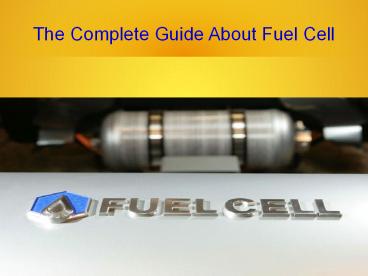Fuel cell - PowerPoint PPT Presentation
Title:
Fuel cell
Description:
A Fuel Cell is a device that converts the Chemical energy from a fuel into electricity through a chemical reaction with oxygen or another Oxidizing agent. Fuel cells are different from batteries in that they require a continuous source of fuel and oxygen/air to sustain the chemical reaction. – PowerPoint PPT presentation
Number of Views:1445
Title: Fuel cell
1
The Complete Guide About Fuel Cell
2
Introduction
- A Fuel Cell is a device that converts the
Chemical energy from a fuel into electricity
through a chemical reaction with oxygen or
another Oxidizing agent. - Fuel cells are different from batteries in that
they require a continuous source of fuel and
oxygen/air to sustain the chemical reaction.
3
- There are many types of fuel cells, but they all
consist of an anode a cathode and an electrolyte
that allows charges to move between the two sides
of the fuel cell. - Fuel cells are used for primary and backup power
for commercial, industrial and residential
buildings and in remote or inaccessible areas.
They are also used to power fuel-cell vehicles,
including forklifts, automobiles, buses, boats,
motorcycles and submarines.
4
How do Fuel cells work?
- The purpose of a fuel cell is to produce an
electrical current that can be directed outside
the cell to do work, - single fuel cell consists of three parts
- 1. Anode (that is a negative electrode that
provides electrons).ssss - 2. An electrolyte in the center.
- 3. Cathode (a positive electrode that accepts
electrons).
5
- The hydrogen is supplied to the fuel cell anode
catalyst on the anode help separate the hydrogen
atoms into protons, hydrogen ions and electrons. - The electrolyte in the center allows only the
proton to pass through the electrolyte to the
cathode side of the fuel cell.
6
- These electrons from the hydrogen cant pass
through the electrolyte and hence pass through a
circuit joined between anode and cathode hence
in turn generate electricity that passes through
that circuit. - As oxygen flows into fuel cell cathode, another
catalyst causes oxygen protons and electrons to
combine to produce pure water heat.
7
Types of fuel cell
- 1.Proton Exchange Membrane Fuel Cells (PEMFC)
- 2. Direct Methanol Fuel Cells (DMFC)
- 3. Phosphoric Acid Fuel Cells (PAFC)
- 4. Alkaline Fuel Cells (AFC)
- 5. Solid Oxide Fuel Cells(SOFC)
- 6. Molten Carbonate Fuel cells (MCFC)
8
Proton Exchange Membrane Fuel Cells (PEMFC)
- Proton exchange membrane fuel cells, also known
as polymer electrolyte membrane (PEM) fuel cells
(PEMFC), are a type of fuel cell being developed
for transport applications as well as
for stationary fuel cell application
and portable fuel cell application.
9
Direct Methanol Fuel Cells (DMFC)
- Direct-methanol fuel cells or DMFCs are a
subcategory of proton-exchange fuel cells in
which methanol is used as the fuel. - Their main advantage is the ease of transport of
methanol, an energy-dense yet reasonably stable
liquid at all environmental conditions.
10
Phosphoric Acid Fuel Cells (PAFC)
- Phosphoric acid fuel cells (PAFC) are a type
of fuel cell that uses liquid phosphoric acid as
an electrolyte. They were the first fuel cells to
be commercialized.
11
Alkaline Fuel Cells (AFC)
- The alkaline fuel cell (AFC), also known as
the Bacon fuel cell after its British
inventor,AFCs consume hydrogen and pure oxygen
producing potable water, heat, and electricity.
They are among the most efficient fuel cells,
having the potential to reach 70.
12
Solid Oxide Fuel Cells(SOFC)
- A solid oxide fuel cell (SOFC) is
an electrochemical conversion device that
produces electricity directly from oxidizing a
fuel. Fuel cellsare characterized by their
electrolyte material, - The SOFC has a solid oxide or ceramic electrolyte.
13
Molten Carbonate Fuel cells (MCFC)
- Molten carbonate fuel cells (MCFCs) are currently
being developed for natural gas, biogas (produced
as a result of anaerobic digestion orbiomass
gasification), and coal-based power plants
for electrical utility, industrial, and military
application.
14
Advantages Of Fuel Cells
- Less Greenhouse Gas Emissions Fossil fuels do
emit a lot of greenhouse gases. Same is not
emitted by the fuel cells. - Fuel cells have a higher efficiency than diesel
or gas engines. - Fuel cells can be responsive to changing
electrical loads. - The power densities are high values.
- Fuel cells provide high quality DC power.
- Most fuel cells operate silently, compared to
internal combustion engines.
15
Disadvantages Of Fuel Cells
- High costs compared to other energy systems
technology. - Operation requires a consistent fuel supply.
- The technology is not yet fully developed and few
products are available. - Some fuel cells use expensive materials.
16
weSRCH
Www.wesrch.com
Www.Energy.wesrch.com

